2024 Lucid Air Mega Road Test: We drive'em all, but cheapest Pure steals the show

NEWARK, Calif. – All four versions of the 2024 Lucid Air are before me, from the entry-level Pure to the ballistic-missile-like Sapphire. I’m to drive all of them in a single day on some of the Bay Area’s most beautiful mountain roads. No city stop-and-go or highway cruising involved. Nope, Lucid wants to show off the dynamics of its Air lineup on roads that seem best suited to Porsches, BMW M cars and others of that ilk. The Air is no two-door sports car on the outside, but it becomes clear in a hurry that every single version of this electric, luxury sports sedan belongs in this arena.
Of course, it makes sense that the Air performs well on the roads engineers validated their work on – I’m starting out only a short 20-mile drive from the company’s Newark, Calif. headquarters. While visiting Lucid’s headquarters the previous night, CEO Peter Rawlinson endlessly nerded out about how and why Lucid’s electric powertrain tech contributes to the Air being such an efficient and powerful EV. It’s impossible not to come away impressed at what Lucid has engineered to put its cars in motion, further validated by a car company as prestigious as Aston Martin signing a deal to use Lucid’s electric motors and battery systems in the future. And in case you didn’t realize, Formula E uses Lucid battery and motor technology in its latest generation race cars today. You know what they say: Win on Sunday, sell on Monday … and now that I’ve tried out the road car wares, there’s a good reason why a company like Aston or a racing series like Formula E have taken notice.
2024 Lucid Air Sapphire
Lucid Air Sapphire
The Sapphire is silent violence. It’s also what the Tesla Model S Plaid wishes it was. Both the Lucid and Tesla boast 0-60 times under 2 seconds, but there’s a $160,000 gulf between their starting prices. Only when you’ve driven them both do you understand why the price difference is so stark. Lucid’s Sapphire is a complete, high-performance luxury car from stem to stern, while the Plaid feels like a half-hearted muscle car; a one-trick pony from yesteryear.
To put things into perspective for the gasoline-driven gearheads among us, the Sapphire is to the Air lineup what the M5 Competition is to the 5 Series range. It’s the whole enchilada. Most of its suspension is different than that of other Air models, and it results in a car with a chassis that can handle its copious amounts of power. Which, by the way, is 1,234 horsepower. Sort of. Rawlinson said that’s a completely made-up number (because 1-2-3-4 sounded cool) and that the actual figure is a good bit higher. I don’t doubt that whatsoever after driving it.
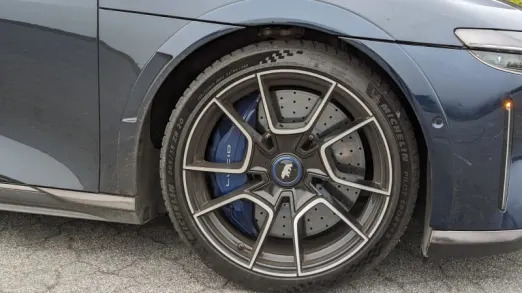
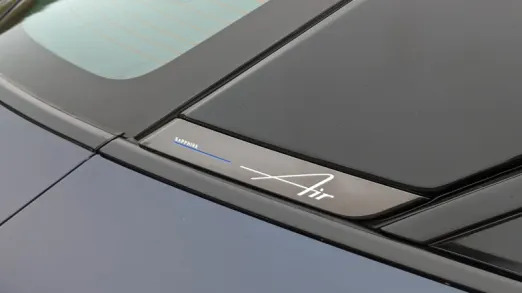
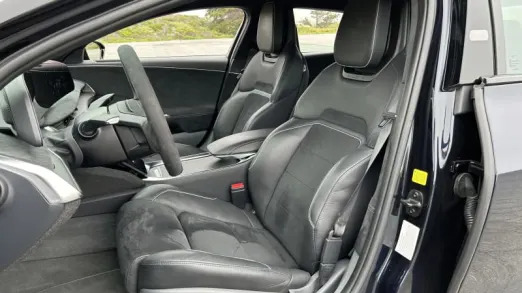
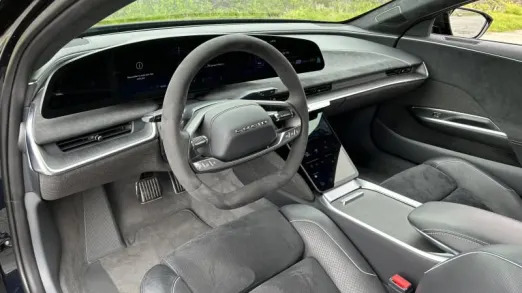
The Sapphire’s chassis is impossible to fluster on a winding road. It darts around corners with such effortlessness that you’ll wonder how such a big, heavy EV manages it. Wider (and staggered) Michelin Pilot Sport 4S tires designed specifically for the Sapphire sit at all four corners, giving it immense amounts of grip. Its carbon ceramic brakes squeal away each time I lay back into them after applying a quick dash of throttle. It slows down in a hurry without any drama or notable dive. Meanwhile, a Plaid’s suspension is so unfit for the car that the tires will literally scrub against the wheel wells should you build up enough Gs. The brakes are a joke for how quickly it can accelerate, and while its low center of gravity helps, you can tell its underpinnings are not up to the task of an intense mountain road, let alone track work.
The Sapphire’s interior completes the performance package, too, as it’s fitted with tremendously comfortable and supportive sport buckets that keep you stuck in while exercising the car’s insanely high capabilities. I’ve hardly said anything about the Sapphire’s acceleration so far, and that’s because somehow, it’s the least important aspect of what makes this car so special. Yes, it’ll leave anyone in awe of how quick it gets up to extralegal speeds, but after driving it around for an hour, I was already coming to terms with and getting accustomed to the shove. EVs are quick, but that single party trick is easy to tire of. Thankfully for the Sapphire, you’re going to have a rollicking good time all the time, no launch control necessary.
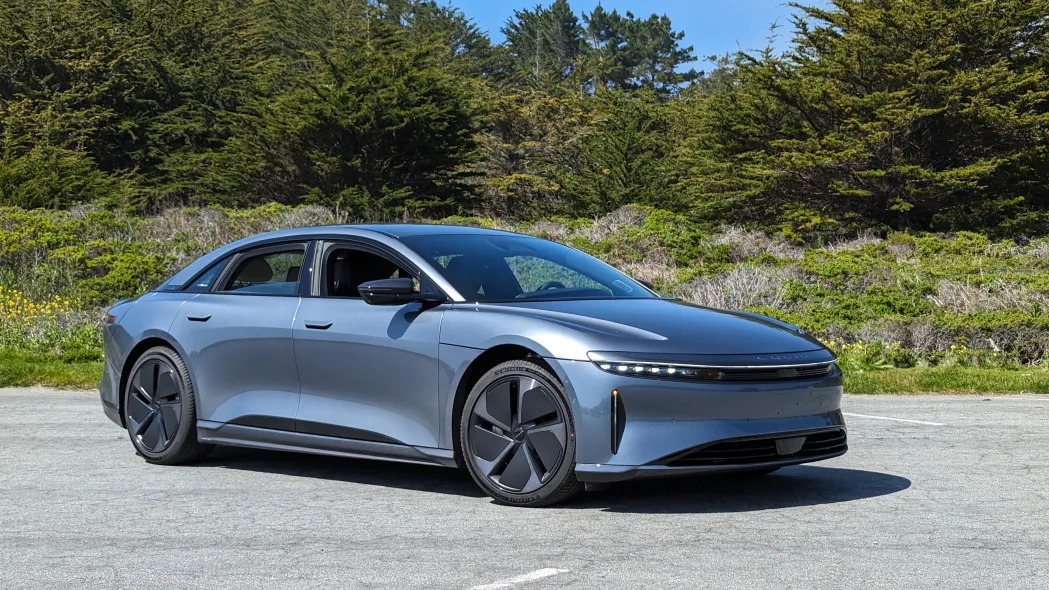
Lucid Air Grand Touring
Lucid Air Grand Touring
Dropping down to the next-most-powerful Air in the lineup brings me to the Grand Touring, a four-door sedan touting 819 ponies from a dual-motor powertrain. It’s still violently quick when you lay into the throttle, but the Grand Touring doesn’t take performance quite as seriously as the Sapphire does. That said, to follow through on the Model S Plaid comparison, the Grand Touring is still a far more dynamic package in every way.
Instead of going max attack, though, I dial it back to take in the Air’s pretty but simple interior. The funkily shaped screens sprawling across the dash may look dominating in photos, but it’s more restrained compared to Mercedes’ Hyperscreen and the proliferation of passenger-side screens. There are blissfully still hard buttons to adjust items like temperature control, media volume and track seeking. However, neither the central scroll wheel nor the steering wheel toggle for volume control are great to use, forcing you to spend way too much time scrolling to get any kind of noticeable volume adjustment.
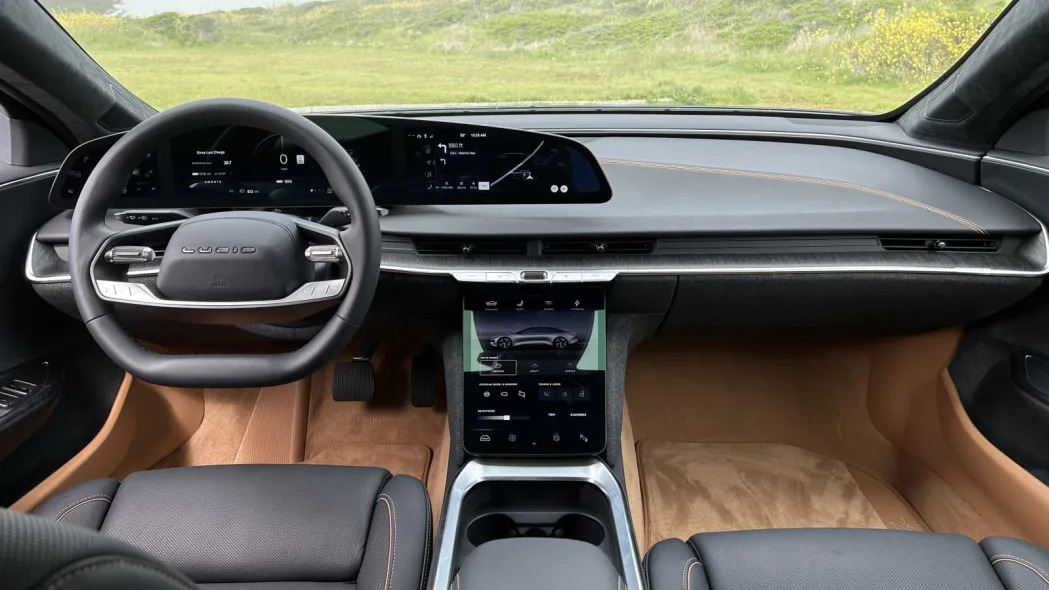
The seats, even if they aren’t as serious as the Sapphire’s buckets, hold me in with sufficient support and excellent comfort, but Lucid should be commended for keeping the seat as low as it has for a more natural sport sedan feeling. Many EVs force you to sit awkwardly high due to the battery pack needing space below the floor, but the Air doesn’t suffer here.
As for how it handles, the short answer is adeptly and confidently. That said, it’s not the best-of-the-rest when it comes to the Air lineup south of the Sapphire. Lucid tells me that it learned quite a lot about suspension and stability control setup when developing the Sapphire, and while it’s applied those learnings to the entry-level Pure, neither the Touring nor the Grand Touring have those updates yet. When driven back-to-back, the dynamic differences are impossible to ignore.
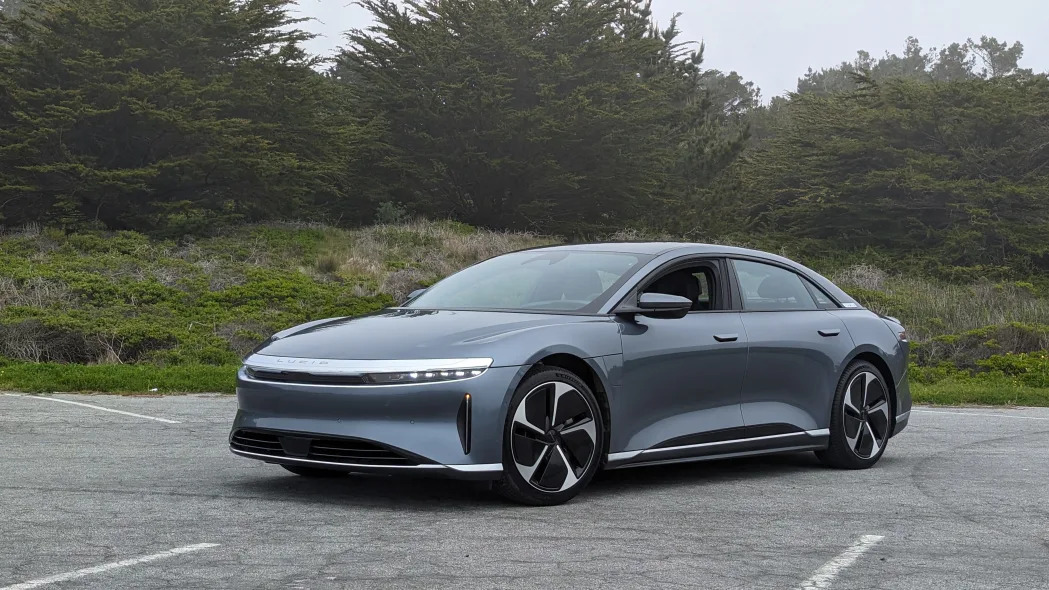
2024 Lucid Air Pure
Lucid Air Pure
Of all the Air versions available, the Pure is the one I’d drive home in. From a performance and value perspective, it’s the best of the bunch. It’s also the slowest, but in the Air lineup, that doesn’t mean a whole lot. The single-motor, rear-drive Pure goes 0-60 in 4.5 seconds and is rated for 419 miles on a full charge, which is beyond good enough on both counts. Its acceleration is plenty rapid, even when charging up a steep mountain pass. Frankly, it’s exactly the amount of shove you want on a winding road. All the other versions of the Air are so quick that your time spent fully in the throttle is severely limited, forcing you to meter power out with restraint. It’s hard to chide a car for being too quick, but I can’t deny that I was having more fun in the Pure that allowed me to get in a much more natural rhythm. Instead of hard brake applications followed by measured throttle presses, you can just use the responsive regenerative braking force to slow yourself prior to corners and hammer it down on the way out.
And I do mean hammer down, because the stability control system (ESC) in the Pure is a joy. Both the Pure and Sapphire use a new in-house Lucid-designed ESC, while the Touring and Grand Touring use an outsourced system. The difference is stark, as the Pure’s rear wheels are virtually impossible to confound, and you’d never even know the electronics are helping. Engineers tell me its in-house ESC allowed for much more granular control and also allowed for the system to react far quicker than the previous one. Where you’d find a little bit of awkwardness or hesitation in the Touring or Grand Touring, it simply doesn’t exist in the Pure. It’s all the more remarkable considering the Pure is exclusively sending its power (430 horsepower!) to the rear wheels while all the other Airs have the benefit of all-wheel drive. That Lucid is able to make the driver feel like all 430 horses are being laid down 100% of the time without wheel slippage or feeling a loss in power is just magic.
Then again, you can relax ESC and get the rear end to step out a bit should you purposely overdrive the car, as any proper rear-drive sports sedan allows. The lack of a front motor is a huge benefit to the car’s overall balance, as it’s far more eager to turn into corners. Plus, its smaller battery pack helps it shed pounds and feel all the more agile in general. Its rear is even happy to provide a touch of rotation as you dip into the brakes. It’s not the kind of lift-off oversteer that made classic Hondas famously rear-happy, but it’s something you’ll notice when hustling it.
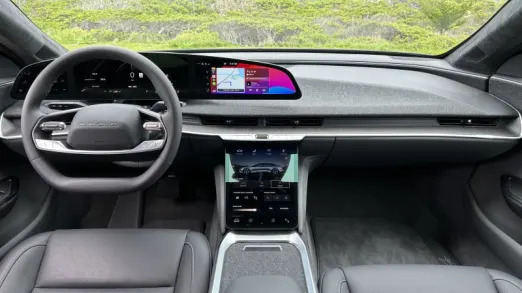
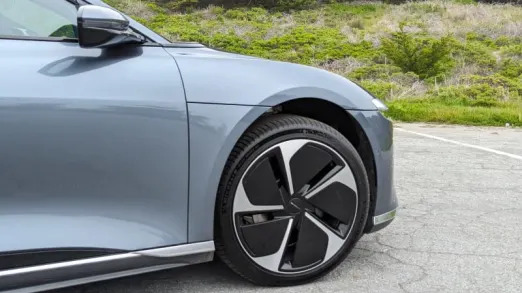
Another revelation that’s instantly noticeable when moving from the Grand Touring to the Pure is how improved the steering is. Not only is the weighting more natural, but just going lock-to-lock is smoother and far more refined. None of the Airs have overboosted steering, but the tune dialed in for the Pure is undoubtedly the most satisfactory. This new steering, suspension tuning and stability control system can’t make its way to the Grand Touring and Touring quick enough, because it all adds up to a more competent-feeling car in every situation.
It’s just icing on the cake that the Pure also happens to be the cheapest of all the Airs, starting at just $71,475. You’ll need to spend a little money to get the most out of its improved dynamics – the $1,750 20-inch wheel package brings wider wheels fitted with Michelin Pilot Sport EV tires (how I tested it). But that still only makes for a $73,225 car, and for that price, it feels like an absolute steal compared to its EV rivals.
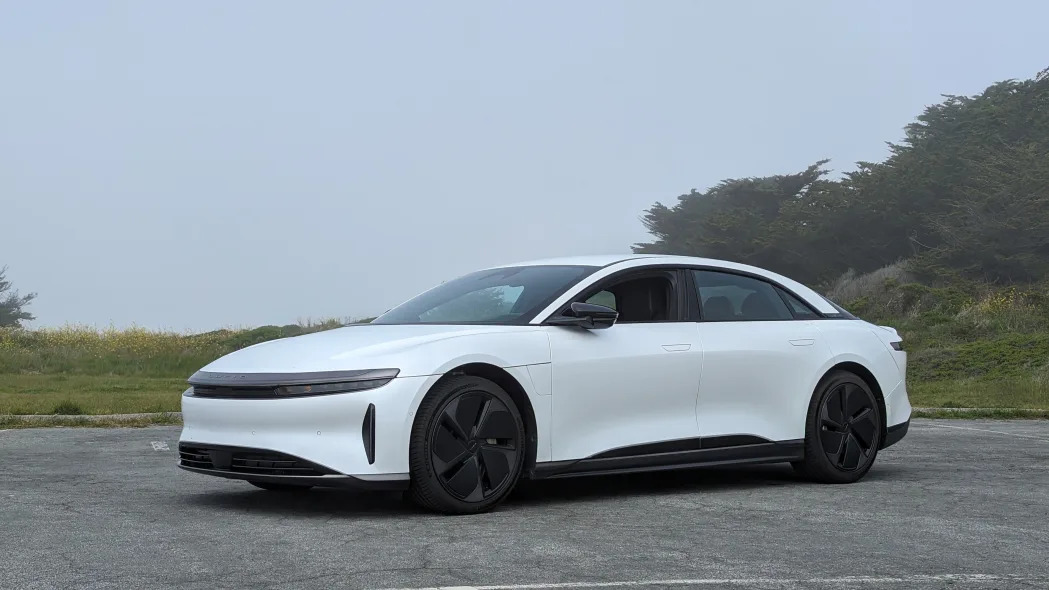
Lucid Air Touring
Lucid Air Touring
I’m ending on what was actually the first Air I drove of the day, the middling Touring model. But again, middling needs to be put into perspective, because this sedan still has 620 horsepower and goes 0-60 mph in just 3.4 seconds. You get this extra performance – and the all-weather all-wheel-drive usability – for just $8,000 more than the Pure. That sounds like a great deal when the benefit is nearly 200 horsepower, but because of all the improvements applied to the Pure, I still think the RWD Air is the better driver’s car.
If you were in the mood for the extra power this Touring provides, though, know it’s still a splendid sport sedan. Its adaptive dampers and steel springs (none of the Airs are fitted with air suspension, despite the Gravity being revealed with that feature) make for a lovely ride-and-handling balance. From Sapphire to this Touring model, all would function as supremely comfortable and capable daily drivers.
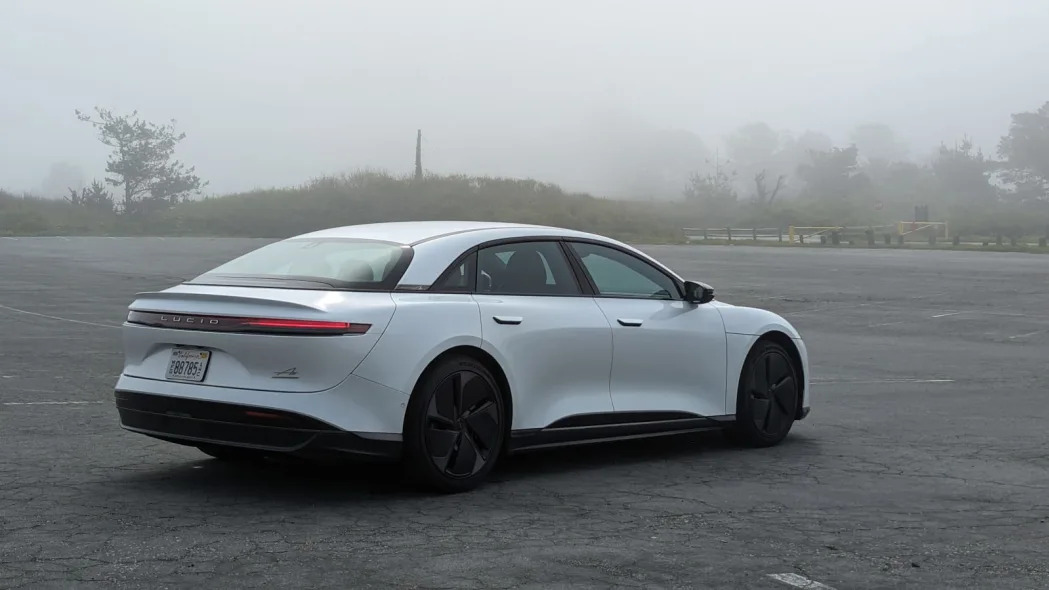
I should also mention that the only technical snag of the day came from this Touring model. Apple CarPlay simply wouldn’t work despite multiple tries to connect and technical help from Lucid. All three of the other Airs connected to CarPlay instantly and seamlessly, but these kinds of snags are the sort we’ve seen in other Air test vehicles. They’re not deal-breakers, but they are the growing pains of a still-new car company.
How competent the whole Air lineup presents itself at this point is also impressive for a totally new car company. You can tell it’s been designed and engineered by a team that has experience and knows what it takes to build a competitive product. And not only is it competitive from a specs, tech and design perspective, but the Air lineup is one that’s designed with the driving enthusiast in mind. That I can blast through demanding mountain roads in every version of the car and have a ball doing so is the mark of a good driver’s car with the right underpinnings – like a BMW 5 Series or Cadillac CT5, every version is going to delight a driver in their own, unique ways. That’s what the Air brings to the table, and as luck would have it, the most affordable Pure model is the one that does it best. How many other sport sedans can you say that about?
Related video:



